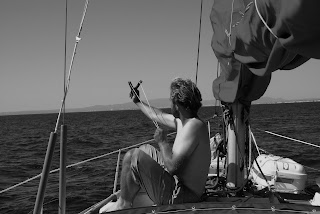When the North wind reaches the shores of Portugal, after several thousand miles unimpeded by land, it faces several miles of cliffs being forced over them... or around! That's what happens in the southwesternmost tip of Europe, where the land does a sudden complete 90º turn, forcing the north wind to suddenlly compress around cape St. Vincent. That's why Sagres is usually so windy, and a winsurfing haven. What most people don't know, is that just 5 miles off Mareta bay (between cape St. vincent and Ponta de Sagres) it's always worse! Unfortunately, that's also where dolphins hang around. We did try to sample, and did get some samples here and there, but it was just too hard. Laura and Heather left shortly after arriving to Sagres, and were replaced by Mário and Pedro Silva, a masters student and CIBIO, doing genetic research on iberian wolves.
Pedro indicating the direction where dolphins are going
Unfortunatelly, the forecast was for even stronger winds for the next week, only calming down after that. At the same time, we could see that just 20 miles to the East, in Portimão, the weather was quite fair. The decision was easy, we had to move to Portimão otherwise we would only stay in port hearing the wind wisthling in the mast. As such, one day, after trying to get some samples and seeing it was hopeless, we set sail and headed to Portimão. We arriving with absolutely no wind! It was looking good for some successfull sampling in Portimão. However, we had still another chalenge in Portimão. This is the area of the Portuguese mainland where the most dolphin-watching companies operate. Unfortunately they have a strategy of, once a group of dolphins is found, they communicate their position to each other, and never leave the group until another boat is there... this all day long. So the first day in Portimão, me Mário and Pedro had a nice dolphin-watching-watching, as we waited in vain to get a breach to do anything. It happened at lunch time, but then dolphins were too sick of boats to care about us, so we did the reasonable and left. We did find another group, but it was late, and the conditions were already harder. We did get some samples though, and we weren't that pressured to be worried.

One of the many dolphin-watching boats we saw that day
Shearwaters, a common companion of dolphins
The next day though, we had it brilliant. We moved somewhere far from the salphin-watching boats, and got enough samples to reach 30.We were delighted. It seemed that the weather and the dolphins were finnally cooperating, and we could have some nice working days.
Photo credit: Mário Mota
Pedro and Mário eventually left, and were replaced by Margarida, Eva and Diana (these girls just can't stay away from this boat!). The forecast for the next week was for no wind, and it started looking as a good chance to do Sagres. As such, one morning we left at dawn and moved to Sagres. Our idea was to get early to Sagres and still try and sample something.

Our plan went better than expected. We found a group but it was just racing through the ocean and paid us no attention. After several hours seeing nothing but wind and waves, I spot a group at the distance. It was far, but worse the try. However, getting clos seemed near to impossible, and everyone else in the boat thought I was seeing things. Just as I was about to give up, the change behaviour and I notice whey were getting closer and closer. Some of them were even discretely approaching the boat, studying if it was worth a visit. Eventually they thought it was and got closer. Little by little, our samples increased. We circled around the same area following the dolphins until we reached the 30 samples. We were all quite pleased, and the outlook was now much better for these two southern locations.
The crew relaxes after a successful day!
However Sagres should never be underestimated, and as we would see, it was not going to be that easy. It seemed we took one of the few opportunities we would have to complete Sagres.















































